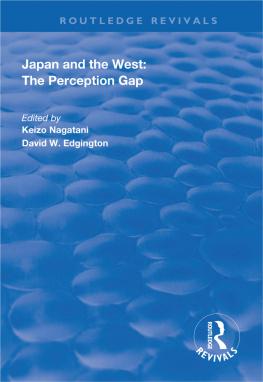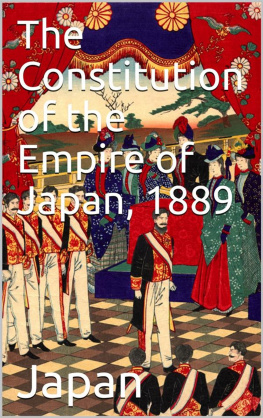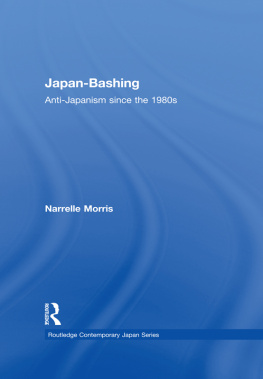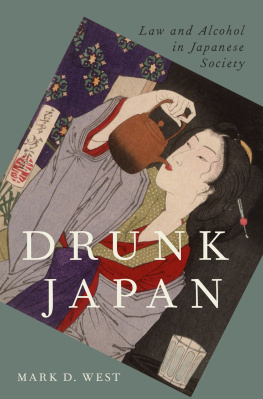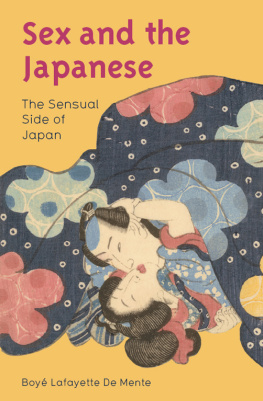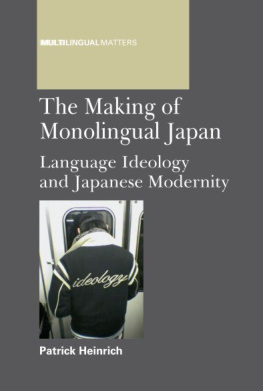Japan and the West: The Perception Gap
Japan and the West: The Perception Gap
Edited by
Keizo Nagatani
The University of British Columbia
David W. Edgington
The University of British Columbia
First published 1998 by Ashgate Publishing
Reissued 2018 by Routledge
2 Park Square, Milton Park, Abingdon, Oxon OX14 4RN
711 Third Avenue, New York, NY 10017, USA
Routledge is an imprint of the Taylor & Francis Group, an informa business
Copyright Keizo Nagatani and David W. Edgington 1998
All rights reserved. No part of this book may be reprinted or reproduced or utilised in any form or by any electronic, mechanical, or other means, now known or hereafter invented, including photocopying and recording, or in any information storage or retrieval system, without permission in writing from the publishers.
Notice:
Product or corporate names may be trademarks or registered trademarks, and are used only for identification and explanation without intent to infringe.
Publisher's Note
The publisher has gone to great lengths to ensure the quality of this reprint but points out that some imperfections in the original copies may be apparent.
Disclaimer
The publisher has made every effort to trace copyright holders and welcomes correspondence from those they have been unable to contact.
A Library of Congress record exists under LC control number: 97077894
ISBN 13: 978-1-138-32404-6 (hbk)
ISBN 13: 978-1-138-32413-8 (pbk)
ISBN 13: 978-0-429-44434-0 (ebk)
Lonny E. Carlile (formerly at the University of British Columbia) is an Assistant Professor in the Center for Japanese Studies and Asian Studies Program at the School of Hawaiian, Asian and Pacific Studies, University of Hawaii at Manoa. His research interests span a broad range of topics in the area of Japanese political economy. Recent publications include 'Economic Development and the Evolution of Japanese Overseas Tourism, 1964-1994', Tourism Recreation Research (1996), and a translation entitled Contemporary Politics in Japan by Masumi Junnosuke (1995). He is currently co-editing a book on economic deregulation in Japan and writing a book on the history of the postwar Japanese labor movement.
Millie Creighton is Associate Professor, Department of Anthropology and Sociology at the University of British Columbia. Her research and publications include work on Japanese mass consumer industries (department stores, advertising, tourism), work and gender issues, education, traditional crafts, and minorities in Japan.
David W. Edgington is Associate Professor, Department of Geography, University of British Columbia. His research centres on Japanese urban and regional restructuring, and Japan's trade and investments in the Pacific Rim. He is the author of Japanese Business Downunder (1990), Japanese Investment in Canada: Recent Trends and Prospects (1992), and co-editor of Planning for Cities and Regions in Japan (1994). He is currently co-writing a textbook on the geography of Japan.
Moritaka Matsumoto is Associate Professor, Department of Fine Arts, University of British Columbia. He earned degrees from Keio University (BA, Aesthetics and Art History), Indiana University (MA, Art History) and Princeton University (MA, Ph.D., Oriental Art and Archaeology). His research centres on comparative studies of the visual culture in the history of Japan and China. His publications include; Proceedings of the Nitobe-Ohira Memorial Conference on Japanese Studies, Panel 2: Japanese Buddhist Art (1984), 'The Iconography of Shaka's Sermon on the Vulture Peak and its Art Historical Meaning', Artibus Asiae (1993), 'Zur Buddhistischen Maleri und Schriftkunst des Dali-Kunigreichs', Der Golschatz der Drei Pagoden (1991), 'Images of Western Women in Nanban Art', The Walls Within: Images of Westerners in Japan and Images of the Japanese Abroad (1988), 'Dairikoku Cho Sho-on ga Bonso-zu Shinron', Bukkyo Geijutsu (1977, 1978), 'Sodai ni okeru Butsuden no Ichi Sakurei', Bukkyo Geijutsu (1984).
Keizo Nagatani is Professor of Economics and Director of the Centre for Japanese research, Institute of Asian Research, University of British Columbia. He is the author of Monetary Theory (1978), Macroeconomic Dynamics (1981) and Political Macroeconomics (1989). His work on the Japanese economy includes 'Japanese Economics: The Theory and Practice of Investment Coordination' (1992), 'On a Recent Trend in Japanese Capital Markets' (1995) and 'Economics and Economic Development' (1995).
Akio Tanaka is a Ph.D. candidate at the Department of Geography, University of British Columbia. His M.A. thesis is entitled 'Tokyo as a City of Consumption: Space, Media and Self Identity' (1994).
Kinya Tsuruta is Professor of modern Japanese literature at the Asian Studies Department, University of British Columbia. His publications include two books on Kawabata Yasunari, a book on ' Mukogawa ', a book of collected essays on modern Japanese novelists, and more than a dozen edited books on modern Japanese fiction including Nihon bungaku ni okeru tasha (1994). He has organized several international conferences on Japanese literature at UBC and elsewhere over the past twenty years. He was a visiting professor at the National Institute of Japanese Literature (Shiryokan) in Tokyo (1983), the National University of Singapore (1991), and the University of Copenhagen (1996), and is a fellow of the Royal Society of Canada (1990).
The editors and authors wish to acknowledge the financial support for this project given by the Japan Foundation and the Centre for Japanese Research. David W. Edgington also wishes to give due thanks to the BC Real Estate Foundation for funding his research. Many thanks also to Alwyn Spies and Shelley MacDonald for typing the text to camera ready state. The book is dedicated to Terry McGee, Director of the Institute of Asian Research at the University of British Columbia, who originally brought this study group together.
Keizo Nagatani
David W. Edgington
This volume is the product of a project in inter-disciplinary scholarship conducted under the auspices of the Centre for Japanese Research (CJR), part of the Institute of Asian Research at the University of British Columbia. The six major essays in this collection () at first sight appear to deal with quite different topics, from the perspectives of several different disciplines and using different methodologies. Nevertheless, they are all dealing with a fundamental problem, which is the gap between peoples' attitudes and behaviour and the perceptions of them held by others in this case the misperceptions of each other's behaviour held by Japan and its Western partners. Three of the authors are Westerners and four are Japanese by origin. By specialty, they represent art history, modern Japanese literature, cultural anthropology, political science, economics and geography. The editors and other contributors came together to work on a common theme of 'perception gaps between Japan and the West' under the sponsorship of the Japan Foundation.
We have been motivated by the fact that after many centuries of cultural, economic, and political interaction between Japan and the West, mutual misunderstandings or perception gaps remain deep and wide. For example, in connection with Japan and the West's recent business and political negotiations, it is often said that lack of progress is due to the inability of either side to sufficiently understand the other's position or intentions. By way of illustration, it has been reported that the West views the term 'deregulation of industry' as the complete elimination of government regulations, while Japan sees it merely as a relaxation of controls. Thus there appears to be a mutual perception gap. This theory has as its premise that the lack of progress in negotiations is due to the inability of either side to sufficiently understand the other's position or intentions. These six essays, together with the introduction and conclusion to the collection, are the outcome of our group research efforts into this kind of perception gap. They illustrate that perception gaps have long been rooted in Japan's interaction with the West, from the earliest times of Portuguese traders and Jesuit missionaries to the recent wave of overseas property investments associated with Japan's 'bubble economy'. We believe that highlighting these gaps in perception, as they manifest in diverse areas and manners from 16th century art, through to modern literature and culture, as well as different behaviour in government-business links, investment strategies, and approaches to real estate development might potentially contribute to a better understanding, if not an immediate narrowing, of the perception gap between Japan and the West. Note, however, that better understanding of these gaps will not necessarily mean less conflict, but it should mean less conflict between Japan and the West over purely 'symbolic issues'. It is our hope that informed conflict should prove more useful and less frustrating to both sides.


